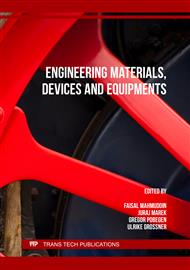p.3
p.13
p.23
p.33
p.41
p.51
p.57
p.69
Mechanical Properties Comparison Between Induction Hardening and Rehardening of Axle Shaft AISI 1043 According to JIS G 0559 Standard
Abstract:
Induction hardening is carried out to increase the hardness of the axle shaft surface. Axle shaft specimens were hardened from the bearing seat area to the spline area of the axle. The hardness requirements of the scope of the shaft met 400-450 HV of the JIS G 0559 standard. The axle shaft's hardening process with induction coil stops in the field before reaching the spline area. It causes the hardness becomes uneven and not comply with the standard. The re-hardening process is often carried out to repair rejected parts. In this work, the result of the re-hardening process is analyzed and compared with the first hardening process—the analysis focus on mechanical properties such as static test (torque test), fatigue testing, and hardness. Microstructures were used to verify the result of the process. The results showed that the results of re-hardening can meet the expected qualifications. The difference in breaking torque (static test) values is 4,428.155 Nm for hardening specimens and 4,287.832 Nm for re-hardening with a standard torque of 4,000.000 Nm, all samples fractured in the spline area. High fatigue values were obtained from the hardening results, with 216,265 cycles and 252,224 cycles for re-hardening. The results of the re-hardening hardness test obtained from Vickers are higher than the hardening results. The results of microstructural testing in both hardening processes contained ferrite and Fe3C on the surface and for the core consisting of ferrite and pearlite. Based on the analysis, the re-hardening process has no significant effect compared with the hardening results. Therefore, in this case, the re-hardening process can be used to fix the failed part.
Info:
Periodical:
Pages:
3-12
Citation:
Online since:
June 2023
Authors:
Keywords:
Price:
Сopyright:
© 2023 Trans Tech Publications Ltd. All Rights Reserved
Share:
Citation:



